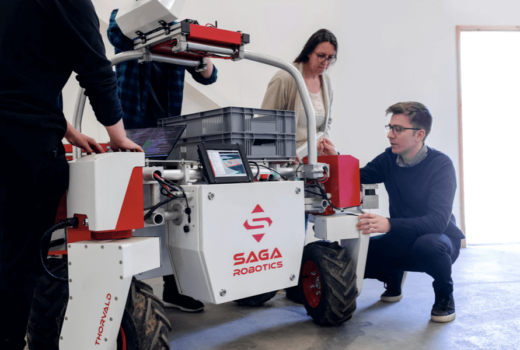Open kennisbronnen goed voor kwaliteit

‘One of the most interesting recent developments in education isthe rapid and vibrant growth of Open Educational Resources (OER),reusable content objects of various kinds which are increasinglyproduced and used in post-secondary education, but also find theirway into secondary education now. Many of these resources aredigital media, but it is interesting to see that the focus of OERsis not on technology per se, but on ways of sharing content. SinceCERI has produced its first overview of the field in 2007, a realexplosion of OERs has taken place. Much of this growth is due tothe popularity of the ‘openness’ movement, including open sourcesoftware and open access journals.
Innovative developments in licensing, more specifically theCreative Commons infrastructure, significantly supported theexpansion of production and use of open resources. OER is now farmore than a tool, it is a community, even a social movement and acampaign. Several organizations, including the OpenCourseWareConsortium and even UNESCO, are monitoring and supporting thesedevelopments.
A significant boost for the further development of OER may comefrom the US government. The US support for OER was already evidentin the National Education Technology Plan published in 2010. Butrecently Education Secretary Arne Duncan, together with hiscolleague from the labor department, announced an ambitious plan toinvest 2 billion US$ in the production of OERs under the most openCC BY licensing. The US government sees OER as a powerful tool toenhance participation and success in post-secondary education, morespecifically community colleges, and to improve the quality andaccessibility of the learning materials.
Indeed, the potential of OERs in educational development andgrowth are enormous. By linking content with technology they may beeven more powerful than technological innovation itself in changingthe face of education. One of its most interesting features is itscapacity to get knowledge flowing. Excessive use of intellectualproperty rights (IPR) in education and research has not contributedto the free flow of knowledge which the knowledge society of the21st century really needs. Some utopian and militant ideas to banall IPR might be overly exaggerated – indeed, scientific findingsneed some protection for some time and also creative products ineducation may deserve some legal protection – but on the wholemodern societies have inflated the use of defensive IPR, therebyprohibiting the free access to knowledge and educational content.The recent progress in the development and use of open licensingsuch as Creative Commons therefore is an excellent thing.
Like many innovations in education – still a sector without awell-developed innovation culture! – the fate of OER will depend onwhat happens after the initial pioneering phase. The enthusiasm ofearly projects and the optimistic political support for them, riskof rapidly becoming very naïve if there is no systemic approach toleverage and mainstream the innovation. The project life cycle ofmany OER initiatives is rather short, there is little concern forscaling up, many initiatives are stuck in a purely supply-drivenapproach and there is very little assessment of efficiency,effectiveness and impact. Besides many beautiful and inspiringinitiatives, there are also many disappointments and real failures.The education system has very few tools and procedures to evaluateinnovations, to learn from failures and to scale successes.
One of OERs’ most innovative dimensions is its departure fromthe traditional fragmented approach which still seems to govern 99%of education today. OER is about sharing, copying, redistributing,editing and rearranging knowledge. It brings the teacher out of hisisolated environment and connects her/him with colleagues facingsimilar challenges. Maybe it is the first systemic innovation ineducation which truly moves education to a form of collaborative,collective practice.
In my view, OER will only be a systemic success with thecapacity of really transforming education in the 21st century, ifit enhances its innovative nature. There is some reason for concernhere. Most OER initiatives concentrate on rather conventionalcontent and focus on access and distribution questions. Somecolleagues fear that OER in doing so is reconfirming rathertraditional curriculum and content development options. Sometimesthe underlying pedagogical approaches and implicit learningtheories are equally traditional.
A slight, but very significant semantic change has happenedrecently in the OER world. More and more people are now speaking of’open educational practices’ (OEPs). The interesting thing is thatsuch practices try to move away from focusing on content productiononly. They try to integrate open content with new approaches oncurriculum design, delivery (including technologically supporteddelivery modes), assessment procedures, etc. In other words, theymove into a much more comprehensive perspective on theteaching/learning interaction. It is by combing openness withforward-looking, constructivist approaches to education andlearning that OERs will unlock their truly innovativepotential.’
Dirk Van Damme, Head of the Centre for Educational Researchand Innovation, OECD
(bron:
Meest Gelezen
Vrouwen houden universiteit draaiende, maar krijgen daarvoor geen waardering
Wederom intimidatie van journalisten door universiteit, nu in Delft
Hbo-docent wil wel rolmodel zijn, maar niet eigen moreel kompas opdringen
‘Burgerschapsonderwijs moet ook verplicht worden in hbo en wo’
Raad van State: laat taaltoets nog niet gelden voor hbo-opleidingen



